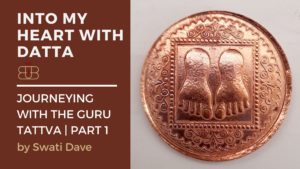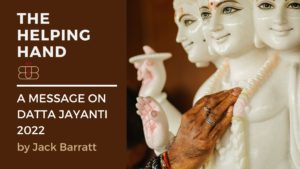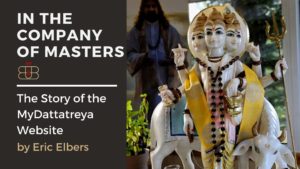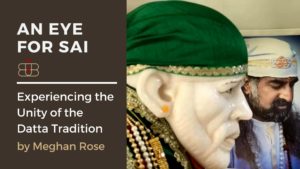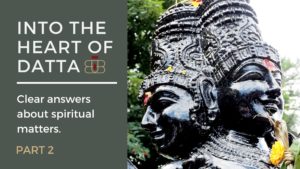Overview and Significance
Siddha Thirumoolar is a Grandfather of Siddhas whose original yogic name was Sundarar Nathar. There is no agreement on when and where he was born and when he lived. Ask six historians when Thirumoolar lived, and you may well get six answers. His time of existence possibly goes 7,000 years back. Others place him in the 10th century. Some scholars believed he lived between the 6th to 7th centuries AD. Some even say his life goes way back to the Ramayana era.
Sundarar Nathar was a disciple of the great Nath guru Maharishi Nandinatha in the Himalayas. Guru Nandhi Natha Devar preached and taught the Nine Veda Agamas (Vedic traditions) that Lord Shiva first taught to Parvathi and then to himself. The great Siddha Nandi Natha blessed his disciple, Sundarar Nathar, and instructed him to undertake the arduous journey to the South of India, to spread monistic Shaiva Siddhanta (attaining liberation through the grace of Lord Shiva) so that mankind may overcome the illusion of separation in the ultimate experience of PARASHIVA (Ultimate Truth Consciousness), where God and soul are one. Having achieved the eight siddhis (spiritual powers) and perfect enlightenment at the feet of his Nath guru Maharishi Nandinatha, Rishi Sundarar Nathar later became known as Rishi Thirumoolar. He joined the venerable Nath lineage and became one of its most celebrated yogis. Of his gratitude to his guru Nandi, he wrote in Thirumandiram:
By Nandi’s grace, master I became;
By Nandi’s grace, I sought Mular;
What can happen without Nandi’s grace?
I remained, seeking to expound Nandi’s path.
By the grace of Nandi, I sought Mular;
By the grace of Nandi, I became Sadasiva;
By the grace of Nandi, I became united with supreme wisdom;
What I am is by the grace of Nandi.
Following his initiation, Sundarar Nathar was sent by Maharishi Nandinatha to revive Shaiva Siddhanta in the South of Bharat (India). Taking leave of Nandinatha and his brother monks, Sundarar Nathar began his life’s mission: to bring the true knowledge of the Agamas (manuals for worship, rituals) and Vedas to the southern parts of India in the Tamil language. It was a long and arduous journey in those days, thousands of kilometers by foot, on simple roads and paths. Scripture notes that Rishi Sundarar Nathar took pains to visit the sacred Shaiva centers en route, beginning with Kedarnath in the North, a remote stone shrine in the snowy Himalayan peaks, at the fountainhead of the river Ganga, near the border of Tibet. Now, apart from his Sat Guru, he sat at the headwaters of the river Ganga. His life’s work lay ahead, his years of learning were complete, and his mystical experiences were swirling all about. He would later write of these early realisations, of the four forms of Shaivism, the four stages, the four relationships the soul has with God, the four realisations attainable, the four aspects of the descent of grace, and the power of true renunciation of the world.
Thirumoolar is one of the 18 Siddhars. His main work is the Thirumandiram (literal meaning – ‘Sacred mantra’ or ‘Holy incantation’) that describes various aspects, from Science and Medicine to the Human aspects of Life and the Divine – Lord Shiva (PARASHIVA).
Thirumoolar perceived Siddha Medicine as not merely a science but also as an art. He was a kind of Siddha doctor and was one among eight Siddhas who had seen Nataraja (Lord Shiva) performing the Ananda Tandava or cosmic dance in Chidambaram, in the South of India.
Life History
Sundarar Nathar started the journey from Mount Kailash to meet his friend, Guru Sage Agastya, also a Siddha Master in the Pothigai Hills in South India. Thirumoolar, at that time, was already a very high Siddha Master who had Ashta Siddhis (8 spiritual powers) and Nava Nidhis (9 treasures of God Kubera). On his way, he stopped and worshipped Lord Shiva in Kedarnath, and the Pashupatishvara Temple in Kathmandu, Nepal. Gautama, the Buddha, had preceded him there 300 or 400 years before. At the Shiva temple, Sundarar Nathar reflected on the Buddha’s life and teaching, and his own destiny. In pondering the life of Gautama, he gained courage and prepared to continue his pilgrimage. But there was a difference. Thirumoolar was immersed in the overwhelming, ever-consuming, passionate love for Lord Shiva, whereas Buddhism is not. He saw first hand that Divine Love incinerates impurities and purifies the soul.
Use the bone as firewood, chopping the flesh,
Fry it hard in the golden fire;
Unless one’s self mellows and melts with tender love,
One cannot attain Shiva, the priceless gem.
Search! You will find no God like Lord Shiva;
None here can compare with Him; He transcends all worlds;
Golden-hued, His matted locks glow like fire;
He is in the lotus of the hearts.
He went along the banks of the river Ganges and reached Kashi (Varanasi). On the way, he passed through Sri Sailam, Thiru Kalahasti, Thiruvaalangadu, Kancheepuram, Thiruvadhikai, and Veeratam. After passing through Chidambaram he reached Thiruvavaduthurai, situated on the southern riverbank of the Kaveri river.
Reborn as Thirumoolar without Dying
Nearing the end of his journey close to a village Sathanur, an amazing event changed Sundarar Nathar’s life forever. He saw a group of cows surrounding a dead cowherd. The cows were smelling the dead body and crying. This cowherd, who had the name Moolan, was from a nearby village called Sathanur and had been bitten by a snake, and died. Seeing the cows weeping with sorrow so touched was Thirumoolar that he decided to alleviate the sufferings of the poor cows.
He first looked for a place to hide his physical body and found a hollow log. Crawling into the log, where his body would be safe, he entered a mesmerist, cataleptic trance, stepped out in his astral body, walked over to the dead cowherd, lay down on top of the corpse, entered it, and slowly brought it back to life. The first thing he saw upon reanimating Moolan’s body was one of the cows looking into his face, crying big tears from both eyes, tears of joy. All the cows now gathered around their beloved Moolan, licking his face and body with their abrasive tongues and bellowing in bovine joy. After a time, they began to graze as usual, and the sight gladdened Sundarar Nathar’s heart. Moolan, in the meantime, had transformed into Thirumoolar (Holy Moolan).
Later in the evening, Thirumoolar gathered the cows and led them back to the village to their home. Thirumoolar stayed near the border of the village. Moolan’s wife, worried that he had not returned home, set out in search of him. When she approached Thirumoolar, he stepped back and told her that he ‘has no relationship with her,’ and went back to a public place and immersed himself in a yogic state. Moolan’s wife was puzzled, not knowing what had happened to her husband Moolan, and what to do. The next morning she went up to the village leaders and explained her situation to them and what had happened. After investigating Thirumoolar, the village leaders said he was not mad but a real yogi and convinced Moolan’s wife to go back home and follow a spiritual life since her husband Moolan was gone.
Returning to the hollow log, Thirumoolar looked inside and found that his body was not there. He searched for days, looking in every hollow log he could find. Finally, in desperation, he sat in padmasana upon the log where he had left his North Indian (old form) body. Entering deep yoga samadhi, he contacted his Guru, Maharishi Nandinatha. They communed, as mystics do, and he learned that Lord Shiva Himself, through His great power of dissolution, had dissolved the atomic structure of the old body after he was well settled and adjusted to his Tamilian cowherd’s body, with the boon that he could now speak fluent Tamil. He realised that now he could effectively give out to the Tamil-speaking world the truths of the Shaiva Agamas and the precious Vedas, uniting Siddhanta with Vedanta for all time.
Lord Shiva decided to deliver the Vedha Agamam through the cowherd Moolan’s body, which could only speak the Tamil language (South Indian language) at a level that a layperson can easily understand. It was Lord Shiva’s grace that had made his body disappear to engage Thirumoolar into the sacred undertaking of writing Vedas, scriptures, and the true meaning of Lord Shiva Himself in the Tamil language. Thus, he decided to accept the task Lord Shiva had bestowed on him.
Rishi Thirumoolar then traveled towards the Thiruvavaduthurai temple, sat under a Peepal tree (Ficus Religiosa), and went into his yogic samadhi state. He composed the THIRUMANDIRAM with 3,000 hymns uttered whenever he came out of samadhi states and written on palm leaves. Tradition holds that composing one hymn per year took him 3,000 years to compose these hymns. It contains fourfold ways of attaining salvation: SARIYAI (service), KIRAYI (creation), YOGAM (meditation), GYANAM (True Knowledge). Along with 3,000 hymns given by Thirumoolar, 300 mantras were given by him, and 30 preachings. These three revelations will remain forever. However, Thirumoolar did not release his hymns to the world immediately as he thought the world was not yet ready to receive their true nature. He hid (buried) the palm leaves under the earth on which Thirumandiram was written, near the flag pillar near Thiruvavaduthurai temple.
After 4,000 years, a highly respected Naayanmaar, one of the four Nayanmars (the teachers of Shiva) named Thirugnana Sambanathar (Respected True Knowledge Scholar), born in South India, went on an epic pilgrimage to all Shiva temples singing various hymns to Lord Shiva. When he reached Thiruvavadudurai, he perceived the fragrance of the divine Tamil hymns. When he asked others for its source, they started digging where the divine fragrance was intense and found the palm leaves of Thirumandiram hymns. He read the marvelous scriptures and understood with great joy the sheer genius and amazing beauty of Thirumandiram. He then decided to spread the Thirumandiram to the world and started singing its hymns to the world.
There are other accounts that say Thirumoolar Siddhar wrote a single verse each day for 3,000 days. Whatever actually happened, even a year’s meditation would be insufficient to comprehend the subtle and complete Jnana (Absolute Truth) contained in the four-line stanza of each verse in Thirumandiram.

Tradition and Gurus
Both the life and works of Thirumoolar Siddhar are extremely important for Tamil Shaivism and the Siddha tradition. The Thirumandiram unfolds the most profound and subtle realisations of a phenomenal Siddha. It is revered as Siddhanta – ‘the end of ends.’ Siddhar Thirumoolar’s life account is documented in Periya Puranam, as he is also revered as one of the 63 Nayanmars (Respected True Knowledge Scholar).
Thirumoolar’s exposition on the Siddha tradition, the Thirumandiram, is a prime and principal work. It is empowering even the present-day Siddha seekers to receive proper guidance on the path. The verses flow to a majestic 3,000 hymns in number. The Thirumandiram includes songs covering all dimensions of truth, the quantum nature of matter, purity of thought and action, the Ashta Siddhis (eight occult powers), Ashtanga Yoga (eight limbs of Siddha Masters of the Basics 21 yoga), and Tantric teachings of Siddhas and occult topics.
The most treasured verses of the Thirumandiram are Siddhar Thirumoolar’s teachings about the devotional path and the profound aspect of Non-duality. These divine poems also speak of the importance of honouring and preserving the physical body and the ways and means for it. The Thirumandiram is an important and highly resourceful work. It has the potential to be approached in the light of modern thinking and discusses the similarities between theoretical physics (quantum theory) and mystical truths. The Thirumandiram expounds upon all the dimensions of the Siddha Tradition.
Thirumoolar, in praise of his guru Nandi Nathar, acquired a light body and an immortal, deathless state as he has written in Thirumandiram:
‘By the grace of Nandi, I sought and became one with the Truth-Consciousness. By Nandi’s grace, I lived on.‘
Rishi Thirumoolar erased the philosophical divisions in his life, bringing much-needed unity to the kingdoms and their people. This togetherness created an integrated culture that gave rise to countless Shiva temples throughout the South and 1,008 Shiva temples in Sri Lanka. The ever-enduring philosophy of monistic Shaiva Siddhanta—mystic yoga in union with total surrender—satisfied the masses, brought wealth, political stability, and the flourishing of culture. There was peace in those days. Each Shivalingam was regularly bathed. Each yogi and rishi was treated with a reverence usually reserved for God.
Rishi Thirumoolar had seven disciples: Malangan, Indiran, Soman, Brahman, Rudran, Kalangi and Kanchamalaiyan, each of whom established one or more monasteries and propagated the Agamic lore. In the line of Kalangi came the sages Righama, Maligaideva, Nadantar, Bhogadeva (who, some claim, is Bhogar Rishi of Palani), and Paramananda. All this we know from the Thirumandiram itself. But that is precious little, and history offers no trace of subsequent transmissions of power and the great tapas and sadhana performed by those early generations of gurus between 2,200 BCE and 1,710 CE. We do know that the Kailasa Parampara survived those hidden years and remains alive today. The Gurus spoke of their Gurus and their Gurus’ Gurus, bringing us the first clear story in modern times, that of an anonymous Siddha whom we know as Rishi from the Himalayas.
Teachings
It would be difficult to overstate the importance of the Thirumandiram in Shaiva Siddhanta philosophy. It is the earliest full statement of Siddhanta, ‘the end of ends.’ It is perhaps the most complete and profound exposition of the subtle theology of Shaiva Siddhanta ever written, and it is the most extensive of the texts of the early gurus of the Nandinatha (Guru of Thirumoolar) Sampradaya. Within the context of other Shaiva scriptures of South India, the Thirumandiram is the tenth of the twelve Tirumurai or ‘Holy Books’. The Tirumurai have come to be regarded as the very life-breath of the devotional stream of Shaivism. Second in importance only to the Vedas, Upanishads, and Agamas, they are sung daily in temples throughout South India and elsewhere in the world where Shaivites worship.
Thirumoolar refers to Shivam as love. His basic philosophy is love, pure spiritual love to Lord Shiva with no expectations or transactions, and no bargaining for results. The Supreme Being is love and only love. Love is bliss that can be attained by anyone; therefore, mankind, the world, is one family, with love (God) as the basis. The following lines explain that:
- ‘Anbe Shivam’, ‘God is Love’
- ‘Mankind is one, one with God’,
- ‘Let the world experience the same bliss that I have experienced.’
These are three important proverbs/teachings that, even today, people can practice.
Who is God or Paramatma? Thirumoolar has explained in Thirumandiram in verse 2,854 that God is beyond thought and speech; Its very subtlety does not have a start or end beyond time. Truth cannot be explained. From the original cause of truth, all others are created.
Shaivism, the religion Thirumoolar advocates, is a naturalistic religion that allows marriage. Thirumoolar puts forth Lord Shiva Himself as an example. By presenting the Lord in the form of Uma-Mahesvara, which is symbolic of bhoga/bhogya (enjoyment), Thirumoolar endorses marriage.
The Thirumandiram deals with body and soul. Tantric experts say that it is full of references regarding Tantric Yoga. Thirumoolar is considered the Emperor of the Siddha system of medicine. A hypothesis of Thirumoolar in Atomic theory has been reinstated as Nanotechnology in this decade. Thirumoolar’s principles on Physiology in the Siddha system are astonishing. Thirumoolar is the only Siddhar who emphasised a sound mind in a sound body, by which one can achieve mortality through Kalpa yoga procedures. It is to be noted that many medical facts have been given in his treatise ‘Thirumoolar Karukkidai Six Hundred’. Many scholars believe that this book contains the key to medical mysteries.
Thirumandiram consists of Nine Tantras. The First Tantra begins with a synopsis of all that is to follow in this great mystical work of Siddhar Thirumoolar. The topics covered are many, like ‘Transitoriness of the body, wealth, youth, and life of no killing (nonviolence or ahimsa). It also discusses poverty, the dharma of rulers, the glory of giving (charity), in praise of charity, Shiva knows those who love Him, learning, non-learning, morality, and more.’
The First Tantra begins with a beautiful recital about Lord Shiva based on a sequence of numbers:
‘One is He, Two His Sweet Grace
Three He stood, all the Four He Witnessed
Five He conquered, Six He filled
Seven Worlds He pervades, He manifests in Eight, and so he remains.’
Meaning:
One is the Eternal Uncreated Being Shivam
Two are – Shiva and Shakthi.
Three represents- Brahma (creation), Vishnu (preservation), Maheshwar (Dissolution), as well as the Sattva, Tamas, and Rajas Gunas
Four are – 4 vedas Rig, Sama, Yajur and Atharva veda.
Five are – 5 sense organs.
Six are – steps to the final realisation: Padam (sound), Ezhuthu (letter), Mantram (syllable), Kalai (light), Tattvam (principles of matter), and Bhuvanam (world). Also, the six adharas or plexuses (chakras): 1. Muladhara, 2. Svadhishthana, 3. Manipura, 4. Anahata, 5. Visuddhi, 6. Ajna.
Seven represents – Seven Worlds: Bhuloka, Bhuvarloka, Svarloka, Maharloka, Tapoloka, Satyaloka, and Shivaloka.
Eight represents – His pervasiveness through earth, water, fire, air, sky, sun, moon, and Jiva (soul).
Like this, the hymn expounds on Lord Shiva and his attributes that are filled with devotion and love.
In Tantra 2 section 14, Karpa kiriyai (Garba or womb Kriya), Thirumoolar elaborates on the birth process through 41 verses.
He says a man and a woman attempt physical union to express their love. The primal Lord uses the event to bring together the necessary principles that would result in a life form. The twenty-five principles- five senses of knowledge, five senses of action, their five actions, the five elements, and their five subtle qualities, are brought together to create the garbakolagai (the sphere of conception). When the male reproductive organ enters into the yoni or the female reproductive organ, the fifteen principles, ten senses, and the five elements enter the womb through the sexual fluid. They hide at the center of the brow and the top of the head of the fetus. The fetus emerges as the life form if the Lord brings together the eight principles that constitute the subtle body (touch, taste, form, sound, fragrance, intellect, mind, and ego), the ten senses (five senses of knowledge and five senses of action), the five elements (space, air, fire, water, and earth), the three energy channels (ida, pingala and sushumna nadis), the soul, the nine energy centres, and kundalini shakti together. Thus, unless the Lord attaches the subtle elements to the soul, it does not become alive.
The subtle five sheaths (pancha kosha) are attached to the body according to the soul’s karma. The fetus remains without breathing. When the air principle enters the body, it starts to cry for the first time. Thirumoolar summarises that even though the seed for the child is provided by the man and nurtured by the woman, they are not aware of the subtle energies of maya that influence the conception. He says as how the water of the ocean collects, evaporates, and forms salt, all the life forms emerge from the ocean of consciousness and dissolve back into it, by Divine Grace.
The Fifth Tantra is also very special. It gives an understanding of the essential features of the Shaivite religion. This includes the four forms of Shaivism, the four stages, the four relationships the soul has with God, the four realisations attainable, and the four aspects of the Descent of Grace.
The Eighth Tantra covers the essential theological elements of Siddhanta and is undoubtedly one of the most profound. Among the concepts and expositions are: the five sheaths (bodies), the eleven avasthais (states), the three padarthas (pati (Master is GOD)), pasu (individual Soul In ignorance) and pasam (bondage of Maya), and how they are essentially one, the 36 tattvas and their elaboration into 96 tattvas, the four states (waking, dreaming, deep sleep and turiyam or the ‘fourth’, and Turiyateetam or the ‘state beyond the fourth’, the three malas (Maya has three ways it operates), the freeing of the mala (stains or impurity) fettered soul. Where the soul becomes Shivam, leaving behind the tattvas, malas and all avastais, the true Siddhanta where knower, known, and knowledge become one. Siddhar Thirumoolar expounds on one of our (Eternal Truth) – TAT-VA-MASI, which can be translated as THOU ARE THAT.
In the third section of the text is an elaborate exposition of eight-limbed Yoga. Thirumoolar’s ethical preparations known as ‘Yama’ and ‘Niyama’ are presented with additional details not found in the Sanskrit text of Patanjali.
Similarly, particulars of ‘Asanas’ (physical postures), ‘Pranayama’ (breathing exercises), ‘Pratyahara’ (withdrawal of senses from going astray), ‘Dharana’ (fixing the mind on the point), ‘Dhyana’ (meditation or Samadhi,) or absorption are adequately expounded. He has also delineated the attainment of supernatural powers as a result of practicing Yoga. Thirumoolar’s firm conviction is that the practice of Yoga should culminate in the realisation of the oneness of Atman and Brahman (PARASHIVA). He calls this method Shiva Yoga.
51 Syllable Shiva Mantra
Thirumoolar’s 51 syllable Shiva Mantra is very powerful. Whoever starts chanting this mantra gets connected to Truth or Shiva consciousness. It fills all chakras without us focusing on any particular chakra or doing anything. It is a programmed mantra so that the mantra will do everything.
How? One just needs to chant it; it reaches the respective chakras, all nadis, and will activate and work with these. It will cleanse, heal, energise and awaken the Kundalini Shakti energy to connect to the source Shiva/Shakthi consciousness by sheer grace, flowing towards God-Realisation. The 51 letter mantra is based on the pancha boothas (five root syllables) ‘Om Na Ma Si Va Ya’. It helps alignment, which attracts (bestows) good health and wealth. It only occurs in the Siddha tradition as a blessing and great gift by Thirumoolar.
OM
SI VA YA NA MA
YA NA VA SI MA
MA VA YA NA SI
SI YA NA MA VA
VA SI MA YA NA
OM
In summary, Thirumoolar’s Thirumandiram can be considered an encyclopedia of human existence and how one may live a spiritual life amid the worldly one. Tantra’s meaning is like a web, interconnecting the spiritual and material dimensions of life. Also, its emphasis on oneness expresses the thread of unity, which exists behind the many differences of time, country, language, caste, color, religion, higher and lower, happiness and misery, wealth and poverty. This includes all aspects of life and makes life worth living, with dharma, artha, kama, moksha, tapas, yoga, jnana, siddhi, buddhi, planets, days, the art of breathing (pranayama), mantra, tantra, yantra, chakras, meditation, medicine, and many more. In short, the Thirumandiram comprises an all-encompassing treatise of philosophical and spiritual wisdom rendered by Siddhar Thirumoolar in verse form.
Thirumoolar’s Love for his Lord Shiva is expressed in this verse of Thirumandiram:
He is the light behind the perishable body,
Water, earth, sky, fire, and air;
His name is Parapara; He is Shiva, the destroyer;
My Lord is limitless, pervasive everywhere.

Sacred Practices/Sadhana
Shaiva Siddhanta is the name of one of the schools of Hinduism. It is today the oldest, most vigorous, and widely practiced of the six forms of Shaivism. The term Shaiva Siddhanta means ‘the final, or established, conclusions of Shaivism’. Today there are two primary schools of Shaiva Siddhanta. One is the pluralistic school of Meykandar, which holds that God, soul, and world are eternally separate. The other is the monistic school of Thirumoolar, which stresses the ultimate oneness of man and God. Thirumoolar’s lineage is specifically called Shuddha Shaiva Siddhanta.
In the Siddha tradition, there exists great mystical abilities and wisdom. It is said that the Siddhas have realised their oneness with the Supreme God PARASHIVA and have merged as completely as humanly possible with this Divine source of all. With such realisation comes limitless bliss and direct command of every power in the universe. A Siddha Master’s miraculous powers are demonstrated in this lineage. Even just a glance of such a highly realised Siddha can quicken spiritual practice.
After Rishi Thirumoolar returned to Tiruvavaduthurai, he worshiped Shiva, sitting locked in padmasana under the sacred arasu, or bodhi, tree to the west of the shrine. These years were deeply yogic, an inner journey that brought many unfoldments of the nadis, pranas, lights, mantras, and yantras as awareness broke through the chakras following the rise of kundalini to the crown, there to find Shiva’s grace waiting, there to attain final liberation, moksha. The great yogi wrote of these inner explorations in hundreds of esoteric verses of the Thirumandiram.
Fix the two eyes upon the nose,
Contain the prana, and regulate it within.
Seek to abide deep in the peace and freedom from the senses,
There shall be no fear of birth. This is the fruit.
The triangle-shaped muladhara is
From where the kundalini rises, through the sushumna
To the crescent moon facing the middle of the eyebrow.
Myriad shapes spring forth in a beauteous spectacle.
Within you blossom the seven chakras.
They are the Lord’s abode you know not.
When you know how to be one with Him,
There you will see Him, sweet as sugar.
Meditate upon that light of kundalini.
Direct it upwards to the top with the breath.
The ruddy flame of Shiva transcending the cosmic adharas
I sought and found this truth within.
Legend says that once each year he came out of samadhi and gave forth from his meditations a single verse and spoke briefly on its meaning. Since he wrote over 3,000 verses, this would mean he lived over 3,000 years and was born earlier than two millennia ago. Others postulate that he gave forth one verse a day for 3,000 days, and the poetic legend of 3,000 years arose because so much profundity is condensed into these 3,000 verses. It would take a full year of the deepest meditation to comprehend the full import of each four-line stanza.
Whatever actually happened, Thirumoolar’s sacred text has persisted and flourished for 2,200 years. Even today, new translations and editions are being published, and thousands of institutions count it among their philosophical and linguistic treasures. Its final verses speak of the unspeakable Shiva, who is omnipresent and all-pervasive:
The one with the graceful matted locks, the body of golden hue,
Is non-attached, yet totally united;
One who has no cessation, no birth; the Lord
Is distinct from the seven worlds and yet merged in them.
As the Supreme Being, He transcends the seven worlds;
He is the Earth surrounded by the seven seas;
He is grace standing in its true nature;
He is the vision (of the jivas) and stands merged.
My virtuous Lord! He is the leader of the universe;
He is the mahout who controls the world;
He is the one who manifests as the innumerable souls;
He is the one revered as the Supreme God.
He is the resplendent indwelling prana;
He is the Lord of the spreading rays of the sun in the firmament;
He is the wind that blows on the Earth;
He is the wisdom that gleans in the thought.
He is the light behind the perishable body,
Water, earth, sky, fire, and air;
His name is Parapara; He is Shiva, the destroyer;
My Lord is limitless, pervasive everywhere.
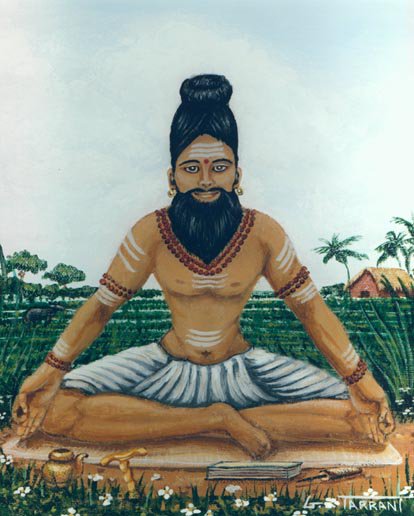
Contemporary Masters
Thirumoolar is one of the greatest Siddhas of the 18 Siddha Masters. The other Siddha masters are Agastya, Ramadevar, Konkanar, Kamalamuni, Sattaimuni, Karuvurar, Sundaranandar, Valmiki, Nandidevar, Pambattisiddhar, Bhoganathar, Macchamuni, Korakkar, Pathamchali, Dhanvanthiri, Kuthambai Siddhar and Edaikkadar.
These 18 Siddhas work together with specialisation of spiritual powers. For example, the most famous disciple of Siddhar Bhoganathar is Siddha Kriya Babaji, considered an incarnation of Lord Kartikeya. The latter is a Universal Master connected to all traditions (Siddha, Nath, Kriya, Datta, Srividya) and has the responsibility of spiritually uplifting humanity. Babaji’s specialty is creating and guiding Masters.
Thirumoolar Is an Immortal Being, available even today in subtle ways. Siddha Masters like Thirumoolar are guiding seekers who want to serve, help, and bring healing to humanity. Then, automatically grace starts flowing from these Siddha Masters.
Holy Sites and Pilgrimages
Siddha Thirumoolar attained Jeeva Samadhi in Chidambaram, in the Southern Part of India. It’s the one behind Chidambara Rahasiyam that is the secret of Chidambaram. It is also in the center of the Geomagnetic equator of planet Earth.
‘Shiva lingam is of the form of the human body; So is Chidambaram; So is Sadashivam; and so is His divine dance,’ says Thirumoolar in Thirumandiram. Chit (wisdom) and ambaram (space or sky) are found here. Here Lord Shiva is the Nataraja Form (Dance Form) which symbolises creation, protection, destruction, hiding and bestowing.
Lord Shiva shows form and formlessness (Ardhanareeswara), which is called Chidambara Rahasya (secret). The Chidambara Rahasya unfolds when the priests remove the curtain behind the Nataraja Vigraham (idol). Once the curtain is removed, one will see only the hanging garland of Bilva Patra (sacred leaves offered to Lord Shiva) and nothing else. Meaning – detachment from Maya (illusions) when the realisation of Self happens from form to formless. Lord Shiva’s dance is called Ananda Tandava here in Chidambaram, elsewhere it is called cosmic dance. Sages Patanjali and Thirumoolar also saw Nataraja’s dance in Chidambaram. The Chidambaram temple is in Cuddalore District in South India. The nearest airports are Chennai and Pondicherry. Regular trains and bus transportation are easily available.

